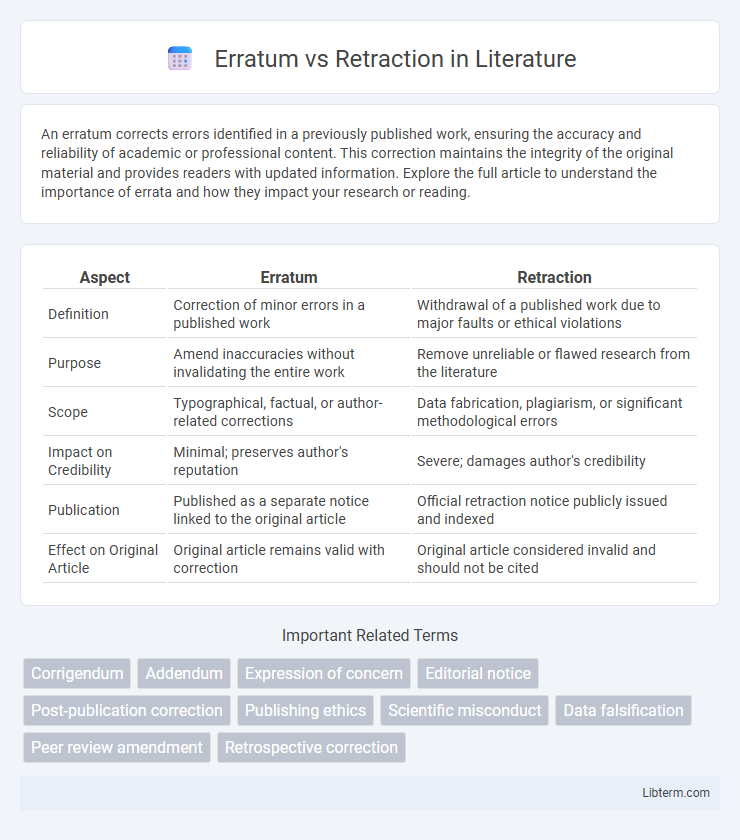An erratum corrects errors identified in a previously published work, ensuring the accuracy and reliability of academic or professional content. This correction maintains the integrity of the original material and provides readers with updated information. Explore the full article to understand the importance of errata and how they impact your research or reading.
Table of Comparison
| Aspect | Erratum | Retraction |
|---|---|---|
| Definition | Correction of minor errors in a published work | Withdrawal of a published work due to major faults or ethical violations |
| Purpose | Amend inaccuracies without invalidating the entire work | Remove unreliable or flawed research from the literature |
| Scope | Typographical, factual, or author-related corrections | Data fabrication, plagiarism, or significant methodological errors |
| Impact on Credibility | Minimal; preserves author's reputation | Severe; damages author's credibility |
| Publication | Published as a separate notice linked to the original article | Official retraction notice publicly issued and indexed |
| Effect on Original Article | Original article remains valid with correction | Original article considered invalid and should not be cited |
Introduction to Erratum and Retraction
Erratum refers to a correction of minor errors in a published work that do not affect the overall validity or conclusions, such as typographical mistakes or author name misspellings. Retraction is a formal withdrawal of a publication due to significant errors, misconduct, or invalid results that compromise the integrity of the research. Both processes serve to maintain the accuracy and reliability of scientific literature by addressing different levels of post-publication issues.
Defining Erratum: What Is It?
An erratum is a correction issued for a minor error in a published work, such as typographical mistakes, factual inaccuracies, or author name misspellings that do not alter the overall findings or conclusions. It serves to maintain the integrity and accuracy of the scholarly record without invalidating the research. Unlike a retraction, an erratum addresses small corrections while the original article remains valid and citable.
Understanding Retraction: Key Characteristics
Retraction is a formal withdrawal of a published scientific paper due to significant errors or ethical breaches that invalidate the study's findings, ensuring the integrity of the academic record. Unlike erratum, which corrects minor mistakes without affecting the overall conclusions, retraction removes the article from the literature to prevent misinformation propagation. Key characteristics include clear notification by the journal, transparency about the reasons, and indexing updates in databases such as PubMed and Web of Science to alert researchers.
Major Differences Between Erratum and Retraction
Erratum refers to minor errors in a published work that do not affect the overall findings, often corrected through a formal notice to preserve the integrity of the scientific record. Retraction involves the withdrawal of a publication due to significant issues such as data fabrication, plagiarism, or serious methodological flaws that invalidate the research conclusions. The major difference lies in the severity and impact: erratum addresses non-critical mistakes while retraction signifies fundamental problems necessitating removal of the study from the literature.
Common Reasons for Issuing an Erratum
Common reasons for issuing an erratum include typographical errors, incorrect author information, or minor data inaccuracies that do not affect the overall conclusions of the research. Errata address these mistakes to maintain the integrity and accuracy of the published work without invalidating the study's findings. This process ensures transparent communication between authors, publishers, and readers while preserving the scientific record.
Typical Causes Leading to Retraction
Typical causes leading to retraction include data fabrication, plagiarism, ethical violations, and significant errors that compromise the validity of research findings. Retractions often result from deliberate misconduct or honest mistakes that render the study's conclusions unreliable or untrustworthy. In contrast, errata address minor errors that do not affect the overall integrity or reliability of the scientific work.
The Impact of Errata on Scientific Literature
Errata address minor errors in published scientific articles without invalidating the main findings, helping maintain the integrity of the literature by correcting details such as data mislabels or author names. They contribute to transparency and trust in research by ensuring accuracy while preserving the study's credibility and citation value. Unlike retractions, which withdraw the entire article due to significant flaws or misconduct, errata support ongoing scholarly communication by clarifying and refining existing knowledge.
Consequences of Retraction for Authors and Journals
Retraction carries severe consequences for authors, including damaged reputations, loss of credibility, and potential career setbacks due to questioning of research integrity. Journals face diminished trust and impact factor declines as retractions signal lapses in peer review and editorial oversight. Both authors and journals must navigate the long-term implications on scientific accuracy and public perception after retraction notices are issued.
Best Practices for Handling Corrections in Publishing
Erratum and retraction serve distinct purposes in publishing corrections: erratum addresses minor errors that do not invalidate the research, while retraction removes flawed or unethical work to maintain scholarly integrity. Best practices for handling such corrections include prompt identification, transparent communication, and clear labeling in published content to ensure readers are aware of the changes. Proper documentation and adherence to publisher policies further uphold trust and accuracy in the academic record.
Conclusion: Maintaining Integrity in Academic Publishing
Erratum and retraction serve distinct roles in preserving academic integrity, with errata correcting minor errors that do not undermine research validity, while retractions address significant flaws or misconduct compromising study reliability. Transparent communication through timely errata and retractions upholds scholarly trust and protects the scientific record. Effective editorial policies and author responsibility are crucial for maintaining the credibility of academic publishing.
Erratum Infographic

 libterm.com
libterm.com